Soybean Growth and Development
Last updated on
February 19, 2015
Slide show (requires
PowerPoint XP or later version)
PDF of slides
The following is derived from the website How A Soybean Plant Develops (ISU Special
Report No. 53)

Growth, development, and yield of soybeans are all a result of a given variety's
genetic potential interacting with its environment. In a field situation, nature
provides the major portion of the environmental influence on soybean development
and yield; however, soybean producers can manipulate this environment with proven
managerial practices. It is the producer's task to provide the best possible growth
environment for the soybean plant by using such management practices as wise tillage
and fertilization of the soil, selecting the most suitable varieties and plant densities,
timely weed and insect control, and many other practices.
A producer needs to understand soybean growth and development. A producer who understands
the soybean plant can use production practices more efficiently to obtain higher
yields and profit.
Soybean Maturity Groups
Soybean varieties are classified for their morphological (form and structure) growth
habit, and for their daylength and temperature requirement to initiate floral or
reproductive development. The indeterminate growth habit is typical of most Corn
Belt soybean varieties and is characterized by a continuation of vegetative growth
after flowering begins. Determinate soybean varieties characteristically have finished
most of their vegetative growth when flowering begins and are typically grown in
the southern United States.
The classification for maturity is based upon the adaptability of a soybean variety
to effectively utilize the growing season in a given region. These regions of adaptability
are long belts, east and west, and relatively short 100-150 miles distances north
and south. Soybean varieties adapted to a particular region are given a group number
from 00 for the northernmost region in northern Minnesota and North Dakota, to VIII
for the southernmost region in the United States, which includes Florida and the
southern parts of the Gulf Coast states. Most varieties in 00 to IV display the
indeterminate growth habit, and varieties in groups V to VIII are mostly of the
determinate growth habit.
An early maturing variety may develop fewer leaves or progress through the different
stages at a faster rate, especially when planted late. A late maturing variety may
develop more leaves or progress more slowly.
The rate of plant development for any variety is directly related to temperature,
so the length of time between the different stages will vary as the temperature
varies both between and within the growing season.
Deficiencies of nutrients, moisture, or other stress conditions may lengthen the
time between vegetative stages, but shorten the time between reproductive stages.
Soybeans planted at high densities tend to grow taller and produce fewer branches,
pods, and seeds per plant than those planted at low densities. High density soybeans
also will set pods higher off the ground and have a greater tendency to lodge.
The Iowa State University staging system divides plant development into vegetative
(V) and reproductive (R) stages . Subdivisions of the V stages are designated numerically
as V1, V2, V3, through V(n) except the first two stages, which are designated as
VE (emergence) and VC (cotyledon stage). The last V stage is designated as V(n),
where (n) represents the number for the last node stage of the specific variety.
The (n) will fluctuate with variety and environment. The R stages are subdivided
into eight stages.
Vegetative and reproductive stages of a soybean plant.

|
Vegetative Stages
|
Reproductive Stages
|
|
VE Emergence
|
R1 Beginning bloom
|
|
VC Cotyledon
|
R2 Full bloom
|
|
V1 First-node
|
R3 Beginning pod
|
|
V2 Second-node
|
R4 Full pod
|
|
V3 Third-node
|
R5 Beginning seed
|
|
*
|
R6 Full seed
|
|
*
|
R7 Beginning maturity
|
|
V(n) nth-node
|
R8 Full maturity
|
The V3 stage is defined when the leaflets on the 1st (unifoliolate) through the
4th node leaf are unrolled. Similarly, the VC stage occurs when the unifoliolate
leaves have unrolled.
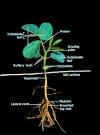
The unifoliolate leaf node is the first node or reference point from which to begin
counting upward to identify upper leaf node numbers. This node is unique in that
the unifoliolate (simple) leaves are produced from it on opposite sides of the stem
and are borne on short petioles. All other true leaves formed by the plant are trifoliolate
(compound) leaves borne on long petioles, and are produced singularly (from different
nodes) and alternately (from side to side) on the stem.
The cotyledons, which are considered modified leaf storage organs, also arise opposite
on the stem just below the unifoliolate node. When the unifoliolate leaves are lost
through injury or natural aging, the position of the unifoliolate node can still
be determined by locating the two leaf scars on the lower stem that permanently
mark where the unifoliolate leaves had grown. These unifoliolate leaf scars are
located just above the two opposite scars which mark the cotyledonary node position.
Any leaf scars above the opposite unifoliolate scars appear singularly and alternately
on the stem, and mark node positions where trifoliolate leaves had grown.
All plants in a given field will not be in the same stage at the same time. When
staging a field of soybeans, each specific V or R stage is defined only when 50
percent or more of the plants in the field are in or beyond that stage.
Germination and Emergence



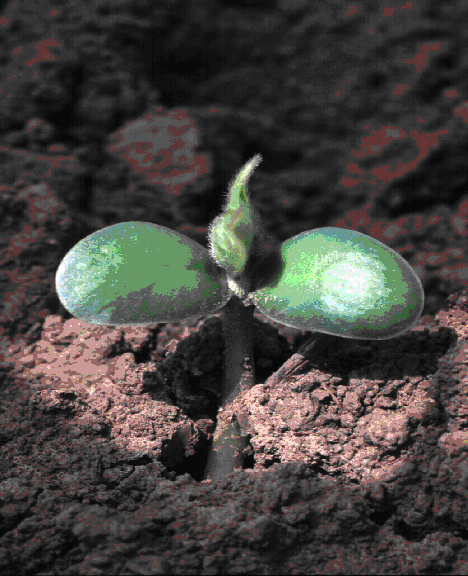

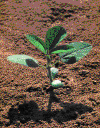
The planted soybean seed begins germination by absorbing water in amounts equal
to about 50 percent of its weight. The radical or primary root is first to grow
from the swollen seed where it elongates downward and anchors itself in the
soil. Shortly after initial primary root growth, the hypocotyl (small section of
the stem between the cotyledonary node and the primary root), begins elongation
toward the soil surface pulling the cotyledons (seed leaves) with it. The anchored
primary root and elongating hypocotyl provide leverage for pulling the cotyledons
to the soil surface for VE or emergence. VE typically occurs 1 to 2 weeks after
planting, depending on soil moisture, soil temperature, and planting depth. Lateral
roots begin to grow from the primary root just prior to emergence.
Under favorable conditions, the primary root and several major laterals grow rapidly
and may reach a depth of 2.5 to 3.25 feet by V6. During late vegetative and early
flowering (V6 to R2), the root system is expanding at its fastest rate. Most of
this growth occurs in the upper 12 inches of soil, if adequate soil moisture is
available. Some roots surface. By R6, under favorable conditions, soybean roots
may have reached depths greater than 6 feet and have spread 10 to 20 inches laterally.
Roots are growing very slowly at this stage, but some root growth continues until
physiological maturity (R7).

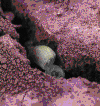
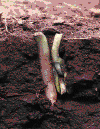
Shortly after VE, the hook-shaped hypocotyl straightens out and discontinues growth
as the cotyledons fold down. The unfolding of the cotyledons exposes the growing
epicotyl (young leaves, stem, and growing point located just above the cotyledonary
node). The subsequent expansion and unfolding of the unifoliolate leaves marks initiation
of the VC stage, which is followed by the numbered (nodal) V stages.
Nutrients and food reserves in the cotyledons supply the needs of the young plant
during emergence and for about 7 to 10 days after VE, or until about the V1 stage.
During this time, the cotyledons lose 70 percent of their dry weight. Loss of one
cotyledon has little effect on the young plant's growth rate, but loss of both cotyledons
at or soon after VE will reduce yields 8 to 9 percent.
After V1, photosynthesis by the developing leaves is adequate for the plant to sustain
itself.
New V stages will appear about every 5 days from VC through V5, and every 3 days
from V5 to shortly after R5 when the maximum number of nodes is developed.
Management Guidelines
- In most cases, soybeans should be planted at a depth of 1 to 1 1/2 inches and never
deeper than 2 inches. The ability of the germinating soybean seedling to push through
a crusted soil decreases with deeper planting. Some varieties are especially sensitive
to deep planting. In addition, the cooler soil temperatures at greater depths cause
slower growth and decreased nutrient availability.
- Small amounts of fertilizer placed in a band 1 to 2 inches to the side and slightly
below the seed may stimulate early plant growth if soil temperatures are still cool.
Roots are not attracted to this fertilizer band, so the fertilizer must be placed
where the roots will be. Fertilizer placement too near or with the seed can injure
the young plant.
- A portion of the nitrogen used by the soybean plant is made available by fixation
of N from the air by Rhizobium japonicum bacteria in the root nodules. These
bacteria infect the roots causing nodule production as early as the V1 stage, .
Throughout the V stages, the number of nodules increases along with the rate of
N fixation. At about R2, the N-fixation rate increases dramatically, peaks at about
R5.5, and drops rapidly thereafter.
- Weeds compete with soybeans for moisture, nutrients, and sunlight. Tillage operations,
herbicides, uniform stands, and crop rotations are useful methods for controlling
weeds. The rotary hoe is an excellent tool for early weed control before and shortly
after the soybeans have emerged .
- Seed inoculation with Rhizobium japonicum bacteria is generally not recommended
unless the field has never grown soybeans, or has not grown soybeans for the past
5 or more years.
V2 Stage (second node)



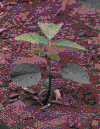
At the V2 stage, the plants are 6 to 8 inches tall and three nodes have leaves with
unfolded leaflets (the unifoliolate node and the first two trifoliolate leaf nodes).
Soybean roots normally become infected with Rhizobium japonicum bacteria,
which cause formation of round or oval shaped root growths termed nodules. Millions
of these bacteria are located within each nodule and provide much of the soybean
plant's nitrogen supply through a process called nitrogen fixation. Through nitrogen-fixation,
the bacteria change nonavailable N2 gas from the air into nitrogen products that
the soybean plant can use. The plant in turn provides the bacteria's carbohydrate
supply. A relationship such as this, where both the bacteria and plant profit from
the other, is called a symbiotic relationship. Nodules actively fixing nitrogen
for the plant appear pink or red on the inside, but are white, brown, or green if
N-fixation is not occurring.
Under field conditions, nodule formation can be seen shortly after VE, but active
nitrogen-fixation does not begin until about the V2 to V3 stages. After this, the
number of nodules formed and the amount of nitrogen fixed increases with time until
about R5.5 (midway between R5 and R6) when it decreases sharply.
Management Guidelines
- Nitrogen fertilization of soybeans is not recommended because it generally does
not increase grain yields. The total number of root nodules that form decreases
proportionately with increasing amounts of applied N. In addition, N fertilizer
applied to a soybean plant with active nodules will render the nodules inactive
or inefficient proportionately to the amount of N applied. Thus, the soybean plant
can utilize both fixed N from bacteria and soil N (both mineralized and fertilizer
N), but soil N is utilized over fixed N if available in large amounts.
- At V2, the lateral roots are proliferating rapidly into the top 6 inches of soil
between the rows, and by V5 will completely reach across a 30-inch row. Because
these roots are growing close to the soil surface, cultivation to control weeds
should be shallow.
V3 and V5 Stages (third and fifth nodes)


Plants at V3 are 7 to 9 inches tall and four nodes have leaves with unfolded leaflets.
Plants at V5 are about 0 to 12 inches tall and six nodes have leaves with unfolded
leaflets.
The upper angle junction between the main stem and a leaf petiole is called an axil.
In each axil is an axillary bud, which is similar in nature to the main stem growing
point. This bud, however, may develop into a branch, develop into a flower cluster
and finally pods, or it may remain dormant (inactive).
The number of branches that develop increases with wider row spacings and lower
plant densities, depending on the variety grown. From zero to six branches typically
develop under field conditions. Generally the largest branch is the lowest on the
main stem and progressively smaller branches develop farther up. Each branch develops
trifoliolate leaves, nodes, axils, axillary buds, flowers, and pods similar in nature
to the main stem. The first branch beginning to develop can be seen in the axil
of the first trifoliolate leaf node.
A soybean plant grown without competition from other plants will branch profusely
and develop into a large plant increasing the number of plants in a given area (plant
density) increases plant height and lodging tendencies, reduces branching and pod
number per plant, but allows more pods and beans per unit are up to an optimum plant
density. The optimum plant density is different for different varieties and environments.
At about two node stages (one week) from R1, the axillary buds in the top stem axils
appear bushy and are beginning to develop into flower clusters called racemes. A
raceme is a short, stem-like structure that produces flowers and finally pods along
its length.
The total number of nodes that the plant may potentially produce is set at V5. The
potential total number of nodes that an indeterminate type soybean plant may produce
is always higher than the actual number of nodes that fully develop.
Management Guidelines
- The axillary buds of the unifoliolate and trifoliolate leaves and of the cotyledons,
allow a tremendous capacity for the soybean plant to recuperate from damage such
as hail. The stem apex, or tip growing point, normally exhibits dominance over the
axillary buds (axillary growing points) during vegetative growth of the plant. If
the stem apex is severed or broken off along with part of the stem, however, the
remaining axillary buds are released from this dominance and branches grow profusely.
The plant, therefore, has the ability to produce new branches and leaves after hail
destroys almost all of the above ground foliage. Severing the plant below the cotyledonary
node kills it because there are no axillary buds below this node.
- Leaf and petiole loss begins at V4 to V5 on the lowest node leaves and petioles
and progresses very slowly upward until shortly after R6. At this time, leaf and
petiole loss becomes rapid and continues until R8 when generally all leaves and
petioles have fallen.
V6 Stage (sixth node)

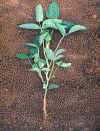
Plants at V6 are 12 to 14 inches tall. Seven nodes have leaves with unfolded leaflets
and both of the unifoliolate leaves and cotyledons may have senesced and fallen
from the plant at this time. New V stages are now appearing every 3 days.
Lateral roots are present completely across row spacings of 30 inches or less by
this stage.
Fifty percent leaf loss at V6 reduces yield approximately 3 percent.

The eight R (reproductive) stages are divided into four parts: R1 and R2 describe
flowering; R3 and R4, pod development; R5 and R6, seed development; and R7 and R8,
plant maturation. Vegetative growth and nodal production continue through some of
the R stages, including the V stage (total number of nodes fully developed). The
R1 through R6 stages of reproductive development better describe plant development.
R1 Stage (beginning bloom)
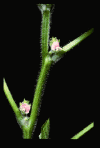 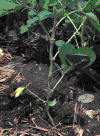
Plants at R1 are 15 to 18 inches tall and are vegetatively in the V7 to V10 stage
(7 to 10 nodes fully developed). Flowering begins on the third to sixth node of
the main stem, depending on the V stage at the time of flowering, and progresses
upward and downward from there. The branches begin flowering a few days later than
the main stem.
These first flowers generally appear at the base of a raceme . With time the raceme
elongates while new flowers appear progressively toward the raceme tip. By the R5
stage, the plant has completed most of its flowering but a few newly opened flowers
may be present on branches and upper main stem nodes. Almost all soybean flowers
pollinate them selves at, or a little before, the time of flower opening.
Three to 4 days after an individual flower opens, the flower petals are dried out
and the pod (fruit) begins to elongate. By 2 to 2 1/2 weeks after this individual
flower opens, a full length pod has formed. Pod growth on the whole plant is rapid
between R4 and R5, since only a few full length pods are present on the lowest nodes
at R4. Many pods have reached mature length at R5, however, and by R6 almost all
pods are mature length.
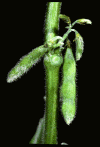
Flowering on a raceme occurs from the base to the tip. Basal raceme pods are thus
always more mature than pods from the raceme tip. Flowering and pod set mostly occur
on primary racemes, but secondary racemes may develop to the side of the primary
raceme in the same axil. The appearance of new flowers peaks between R2.5 and R3,
and is, almost complete by the R5 stage.
At R1, vertical root growth rates sharply increase and stay relatively high to the
R4 to R5 stage. Proliferation of secondary roots and root hairs within the top 0
to 9 inches of soil is extensive during this period also but roots in this zone
generally begin to degenerate thereafter.
R2 Stage (full bloom)

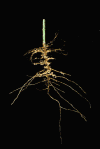
Plants at R2 are 17 to 22 inches tall and are in the V8 to V12 stage. At this stage,
the plant has only accumulated about 25 percent of its total mature dry weight and
nutrients, attained about 50 percent of its mature height, and has produced about
50 percent of its total mature node number. This stage marks the beginning of a
period of rapid and constant daily dry matter and nutrient accumulation rates by
the plant that will continue until shortly after the R6 stage. This rapid accumulation
of dry weight and nutrients by the whole plant initially occurs in the vegetative
plant parts (leaves, stems, petioles, and roots), but accumulation gradually shifts
into the pods and seeds as they begin to develop, and as vegetative parts finalize
their development. In addition, the rate of nitrogen-fixation by the root nodules
is also increasing rapidly by the R2 stage.
Roots are present completely across the inter-row space of 40 inch rows by R2 and
growth of several major lateral roots has turned downward by this time. These major
lateral roots along with the tap root continue to elongate deeply into the soil
profile until shortly after the R6.5 stage.
Fifty percent defoliation at this stage reduces yield about 6 percent.
R3 Stage (beginning pod)

Plants at R3 are 23 to 32 inches tall and are in the V11 to V17 stage. It is not
uncommon to find developing pods, withering flowers, open flowers, and flower buds
on the same plant at this time. Developing pods are located on the lower nodes where
flowering first began.
If plant densities are adequate, yield can be divided into three components:
- the total number of pods produced per plant,
- the number of beans produced per pod, and
- the weight per bean.
Yield = average number of plants per hectare (acre) x average number of pods per
plant x average number of beans per pod x average weight per bean.
Yield increases or decreases may be described as increasing or decreasing one or
more of these three components. Yield increases most generally result from increases
in total number of pods per plant, especially large yield increases. The upper limits
on number of beans per pod and seed size are genetically confined; however, these
two components can still fluctuate enough to produce sizable yield increases.
Stressful conditions such as high temperature or moisture deficiency reduce yield
due to reduction in one or more of the components. Reductions in one component,
however, may be compensated by another component so yields are not significantly
changed. Which yield component is reduced or increased depends on the R stage of
the plant when the stress occurs. As the soybean plant ages from R1 through R5.5,
its ability to compensate after a stressful condition decreases, and the potential
degree of yield reduction from stress increases.
Management Guidelines R1 - R3
- Under Corn Belt conditions, about 60 to 75 percent of all soybean flowers produced
typically abort and never contribute to yield. About half of this abortion occurs
before the flowers develop into young pods, and the other half is due to pod abortion.
The over production of flowers and pods and the extended period of flowering (from
R1 to R5) seems desirable because it offers a degree of escape from short periods
of stress. Stressful conditions (which cause even higher abortion rates) from R1
through R3 generally do not reduce yields greatly because some flowers (and finally
pods) can still be produced until R5 to compensate. In addition, stress at these
stages may result in an increase in the number of beans per pod and weight per bean,
which also help compensate for the aborted flowers and young pods.
- Practices such as fertilization, narrow rows, proper planting rates, irrigation,
and weed control are all attempts to reduce the amount of floral and pod abortion
and thus increase yields.
R4 Stage (full pod)
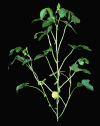
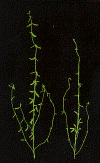


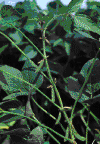
At stage R4 a pod is 3/4 inch long at one of the four uppermost nodes on the main
stem with a fully developed leaf.
Plants at R4 are 28 to 39 inches tall and are in the V13 to V20 stage. This period
is characterized by rapid pod growth and by beginning seed development.
The period from R4 to shortly after R5.5 is a period of rapid steady dry weight
accumulation by the pods. Some individual pods on the lower nodes of the main stem
are full size or close to full size now, but many pods will be full size by the
R5 stage. Pods normally attain most of their length and width before the beans begin
to develop rapidly. Thus, toward the end of this period, some beans within the lower
node pods have begun rapid growth.
Some of the last flowering to occur on the plant is at the main stem tip where a
floral cluster appears. This cluster consists of axillary flowers bunched together
from the tip nodes that haven't separated. Flowering at the upper nodes of the branches
is also the last to occur on the plant.
Management Guidelines
- The R4 stage marks the beginning of the most crucial period of plant development
in terms of seed yield determination. Stress (moisture, light, nutrient deficiencies,
frost, lodging, or defoliation), occurring anytime from R4 to shortly after R6,
will reduce yields more than the same stress at any other period of development.
The period from R4.5 (late pod formation) to about R5.5 is especially critical because
flowering becomes complete and cannot compensate, and because young pods and seeds
are more prone to abort under stress than older pods and seeds. Yield reductions
at this time result mainly from reductions in total pod numbers per plant, with
lesser reductions occurring in beans per pod and possibly seed size. Seed size may
actually compensate somewhat if growing conditions are favorable after R5.5. However,
compensation by seed size is genetically limited. Thus, the plant essentially has
limited ability to compensate for abortion-causing stresses that occur during R4.5
to R5.5.
- Where possible, irrigate to ensure adequate moisture during these crucial periods.
R5 Stage (beginning seed)

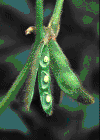
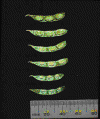
Plants at R5 are 30 to 43 inches tall and are in the V15 to V23 stage. This period
is characterized by rapid seed growth or seed filling, and redistribution of dry
weight and nutrients within the plant to the growing seeds.
At initial R5, reproductive development ranges from flowers just open to pods containing
seeds 8 mm long. Midway between the R5 and R6 stages, several events occur close
to the same time. At about R5.5: (1) the plant attains its maximum height, node
number, and leaf area; (2) the high nitrogen fixation rates peak and begin to drop
rapidly; and (3) the seeds begin a period of rapid, steady, dry weight, and nutrient
accumulation. Shortly after R5.5 dry weight and nutrient accumulation in the leaves,
petioles, and stems maximizes and then begins to redistribute (relocate) from these
plant parts to the rapidly developing seeds. The period of rapid, steady seed dry
weight accumulation continues until shortly after R6.5, during which time about
80 percent of the total seed dry weight is acquired.
Seed yields depend upon the rate of dry weight accumulation in the seeds and the
length of time that dry weight accumulates in the seeds. There is often relatively
little difference between adapted varieties in the rate of dry weight accumulation,
but they do vary in the length of time that dry weight accumulates in the seeds.
Stress may influence both the rate and length of time that dry weight accumulates
in seeds.
Management Guidelines
- Demand for water and nutrients is large throughout the rapid seed filling period.
During this entire period, the beans acquire about half of their N, P, and K by
redistribution from vegetative plant parts, and about half by soil uptake and nodule
activity. This redistribution of nutrients from plant parts occurs regardless of
the soil nutrient avail ability. Water deficiencies may reduce nutrient availability
because roots cannot take up nutrients or grow in upper soil areas where the soil
dries. Thus, at least part of the P and K must be located where the soil will likely
be moist and the nutrients will be available to the plant.
- One hundred percent leaf loss (such as by hail) anytime between R5.0 to R5.5 can
reduce soybean yields by about 75 percent. Stress conditions occurring from the
R5.5 to R6 period also may cause large yield reductions. Yield reductions during
R5.5 to R6 occur mainly as fewer pods per plant and fewer beans per pod; and to
a lesser degree, as less weight per bean.
R6 Stage (full seed)

Plants at R6 are 31 to 47 inches tall and are in the V16 to V25 stage. Because plant
height and node number maximized at about R5.5, little increase in these factors
is evident between R5 and R6.
The R6 bean or "green bean" is characterized by width equal to its
pod cavity; however, beans of all sizes, may be found on the plant at this time.
Total plant pod weight maximizes at about R6.
Growth rate of the beans and whole plant at R6 is still very rapid. This rapid rate
of dry weight and nutrient accumulation begins to slow in the whole plant shortly
after R6, and at shortly after R6.5 in the seeds. Dry weight and nutrient accumulation
maximizes in the whole plant shortly after R6.5 and in the seeds at about R7.
Rapid leaf yellowing (visual senescence) over the plant begins shortly after R6
and continues rapidly to about R8, or until all leaves have fallen. Leaf senescence
and falling begins on the older lowest node leaves, and subsequently spreads upward
to the younger leaves. Three to six trifoliolate leaves may have already fallen
from the lowest nodes before rapid leaf yellowing begins.
Root growth is essentially complete shortly after R6.5.
R7 Stage (beginning maturity)
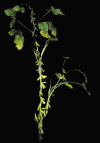
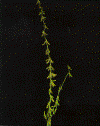

Physiological maturity of an individual soybean seed occurs when the accumulation
of dry weight ceases. This first occurs when the seed (and generally the pod) turns
or has completely lost all green color Although not all pods on the R7 plant have
lost their green color the plant is essentially at physiological maturity because
very little additional dry weight will be accumulated. The soybean seed at physiological
maturity is about 60 percent moisture and contains all necessary plant parts to
begin the next generation soybean plant.
Management Guidelines R6-R7
- As pods and seeds mature, they become less prone to abort. As a result, the total
number of pods per plant and number of beans per pod gradually become set with plant
maturity. Although an older seed may not abort (fall from the plant) under stressful
conditions, the length of the period of rapid seed dry weight accumulation may be
shortened, which in turn causes smaller seed size and reduced yields.
- As the soybean plant matures past R6, the potential degree of yield reduction by
stress gradually declines. From R6 to R6.5 stress may cause large yield reductions
mostly by reducing seed size, but also by reducing pods per plant and beans per
pod. Yield reductions from stress occurring from R6.5 to R7 are much smaller because
the seeds have already accumulated a sizable portion of their mature dry weight.
Stress occurring at R7 or thereafter essentially has no effect on yield.
- Soybean redirects leaf growth toward the sun after a soybean plant partially lodges.
The tendency for lodging increases as plants grow taller. High plant populations,
irrigation, and high seasonal rainfall increase plant height and lodging. Lodging
reduces yields by causing increased harvest losses and inefficient use of sunlight
by the plant.
R8 Stage (full maturity)


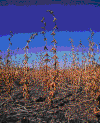
Ninety-five percent of the pods have reached their mature pod color. Five to 10
days of drying weather are required after R8 before the soybeans have less than
15 percent moisture.
The sequence of color and size changes the soybean pod and beans undergo from green
R6 beans to the mature beans ready for harvest. Mature pod color does not always
indicate harvestable readiness of the beans within. With favorable drying weather,
soybeans will lose moisture quickly.
Management Guidelines
- Sub-optimum plant densities become readily apparent at harvest time. Above-optimum
plant densities cause lodged plants that are difficult to harvest, thus leaving
potential yield in the field. Below-optimum plant densities cause branching and
low pod set. Heavily podded branches may break off easily and fall to the ground.
Also, pods produced very close to the ground are difficult or sometimes impossible
to harvest mechanically.
- Timeliness of harvest is very crucial for soybeans. Ideal bean moisture content
at harvest and for storage 13 percent. Although harvest may begin at higher moisture
percentages, some drying costs will be encountered for safe storage. In contrast,
harvest delayed to less than 13 percent moisture causes increased pre-harvest shatter
loss, sickle-bar shatter loss during harvest, increased number of split beans, and
loss of weight to sell.
- To reduce harvest losses: drive at proper speed, and check concave clearance, cylinder
speed, sieves, and air velocity. Be sure reel speed and ground travel are synchronized
to minimize sickle-bar shatter loss. Leave a short stubble. A 3.5 inch stubble contains
5 percent of the crop; a 6.5 inch stubble, 12 percent.
The environment in which a soybean variety grows is extremely influential upon the
plant's development and yield. Environmental stress occurring at any stage of soybean
development will reduce yields. Stress such as nutrient deficiencies, inadequate
moisture, frost damage, hail damage, insect damage, or lodging cause greatest yield
reductions when occurring between the R4 to shortly after R6 stages. Within these
stages, the R4.5 to R5.5 period is especially sensitive to stress. As the soybean
plant matures past R6, the potential amount of yield reduction caused by stress
gradually decreases until R7 when yield is unaffected by stress. Highest yields
are obtained only where environmental conditions are favorable at all stages of
growth.
|